Understanding the Intricacies of 4 Carat Ruby
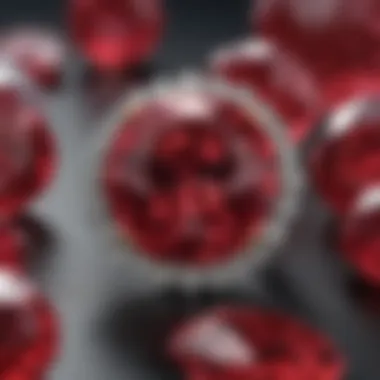
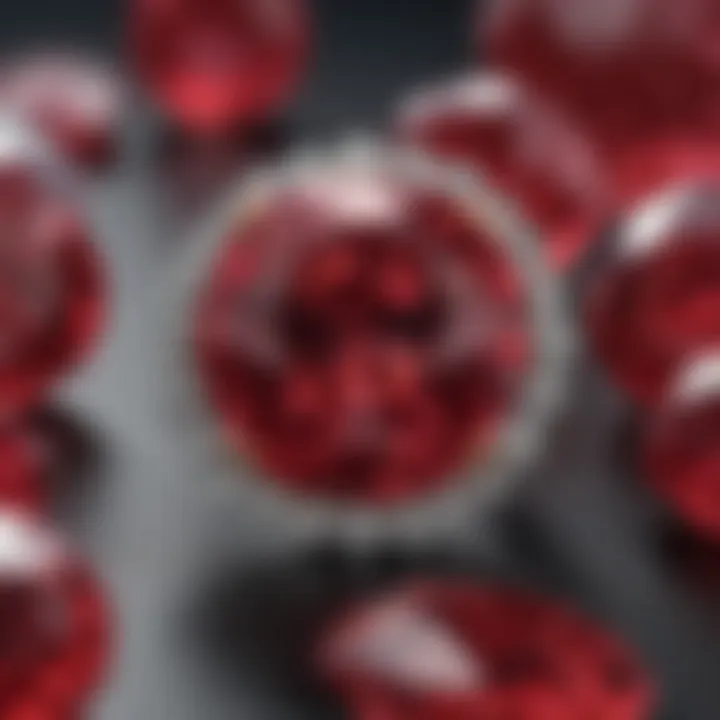
Intro
The allure of 4 carat rubies captivates both collectors and enthusiasts. This article aims to dissect the unique properties, market trends, and importance of these remarkable gemstones. Understanding rubies involves recognizing their value, assessing grading criteria, and knowing how to care for them properly. With this insight, individuals can make informed decisions regarding purchase and ownership.
Gemstone Overview
Definition and Characteristics
Rubies, a variety of the mineral corundum, are distinguished by their deep red hue. The intensity of color can range from light pink to deep blood red. The coloring results primarily from the presence of chromium. The 4 carat ruby's weight indicates its size, and as carat weight increases, so does its value.
Furthermore, rubies are known for their hardness. They score 9 on the Mohs scale, making them suitable for daily wear in jewelry. Other characteristics include excellent clarity and brilliance, factors essential to appraising the ruby’s worth.
Classification of Gemstones
Gemstones are often classified based on various attributes, including mineral composition, color, and rarity. Rubies fall under the category of precious gemstones, along with diamonds, sapphires, and emeralds. This classification stems from their beauty, durability, and significance in human culture.
Gemstones can further be classified into natural, synthetic, and treated stones. Natural rubies are mined from the earth, while synthetic rubies are created in labs. Treated rubies undergo enhancements to improve their appearance, often changing their market value.
Historical Significance
Ancient Uses and Cultural Importance
Historically, rubies have held a prestigious place in various cultures. In ancient times, they were believed to possess protective qualities. Many cultures viewed them as symbols of power and passion. Royalty often adorned themselves with rubies to signify their status and wealth.
The stone's significance extends into the realm of jewelry design. It is often used in engagement rings, necklaces, and other fine jewelry. Additionally, rubies are known as the birthstone for July, enhancing their cultural appeal.
Myths and Legends Surrounding Gemstones
Legends often surround precious stones, and rubies are no exception. In South Asia, rubies were thought to bring good fortune and success in love. In some Indian traditions, the stone was said to protect its wearer from evil forces. Myths complexly link gemstones with both earthly and divine forces throughout history.
"Rubies have long been associated with nobility, wisdom, and courage. Their symbolism adds depth to not only their physical beauty but also to their cultural significance."
Understanding the various historical narratives enhances the appreciation for rubies. This overview sets the stage for exploring market trends and value assessment in the following sections.
Preface to Rubies
Rubies have long fascinated humanity, captivating the hearts of gemstone enthusiasts, collectors, and jewelry designers alike. This section serves as the foundation of our exploration into the world of 4 carat rubies. Understanding rubies involves delving into their origins, historical significance, and the pivotal role they play in various cultures. Their allure is not solely about beauty; it encompasses centuries of history and cultural relevance that enrich their story.
Origin and History
Rubies belong to the corundum family of minerals, alongside sapphires. The word "ruby" originates from the Latin rubens, meaning red. Historically, the allure of rubies dates back to ancient civilizations. They were prized by royalty and often associated with power and protection. Archival records show that rubies were used in ancient India, where they were believed to protect warriors in battle.
In the Middle Ages, rubies became symbols of nobility and were often embedded in crowns and jewelry of the elite. Their striking red hue has captured artistic imaginations, leading to various portrayals in literature and art. This historical significance contributes to their desirability in the current market as a symbol of luxury.
Cultural Significance
Rubies hold profound cultural significance that varies across different societies. In Hinduism, rubies are linked to the sun and are said to bring prosperity and health. They are considered a protective stone, guarding against misfortune. In Burmese culture, warriors believed wearing rubies granted them invincibility. This historical context adds a dimension to rubies that goes beyond aesthetic appeal.
In Western culture, rubies are traditionally associated with love and passion, often given as gifts for anniversaries and special occasions. Their fiery color is a potent symbol of romantic love. Furthermore, rubies have been integrated into various traditions and beliefs, solidifying their importance in both historical and modern contexts.
"The allure of rubies is not just in their beauty; it's embedded in centuries of culture and history."
In contemporary society, the significance of rubies continues as they are sought after in fine jewelry, representing status and investment. Each facet and inclusion tells a story of its journey through time, enhancing its importance in both personal and collective history.
This exploration of the origin and cultural significance of rubies lays important groundwork for understanding the specific characteristics of 4 carat rubies. As we proceed, we will analyze their properties and why they are valued in both the gemology and jewelry sectors.
Understanding Carat Weight
Understanding the carat weight of rubies is essential in evaluating their quality and value. This knowledge not only informs buyers about their potential investment but also guides jewelers and collectors in making educated decisions. While carat weight is a significant factor in gemstone valuation, it is crucial to note that size does not solely determine a ruby's worth.
A single carat is equivalent to 200 milligrams. Rubies, particularly those with a 4 carat weight, are considered substantial and desirable. The importance of carat weight lies in several aspects, including market trends, rarity, and overall appeal. Rubies of this size often attract attention due to their visual impact and potential for magnificence, especially when they exhibit deeper colors and high clarity.
When evaluating carat weight, it is also necessary to consider the overall dimensions of the stone. Two rubies with the same carat weight may differ in size based on their cut and shape. This is where a clearer understanding of the relationship between weight, dimension, and value becomes relevant. The carat weight influences not only how a gem is perceived but also incorporates other criteria that contribute to its overall market value.
In summary, understanding carat weight provides critical insight into the qualities of 4 carat rubies, guiding buyers toward informed decisions without overlooking other influential attributes.
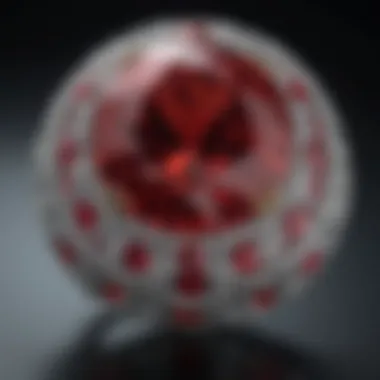
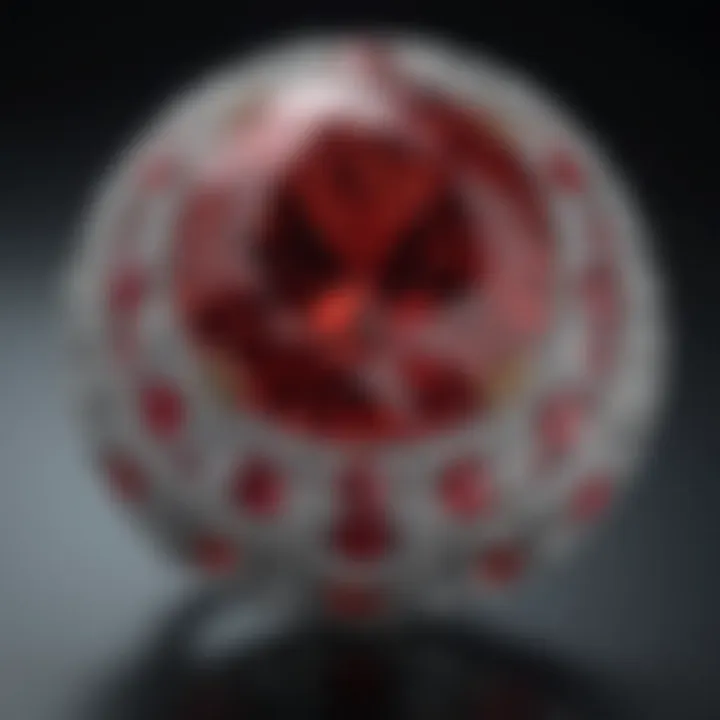
What Does Carat Mean?
The term "carat" refers to the standard unit of weight used to measure gemstones and pearls. It is important to note that the term does not define size, as larger or smaller stones can weigh the same if they have a different density. Therefore, when discussing a 4 carat ruby, the weight directly informs us of the stone's heft but not necessarily its visual presentation.
Originally, carat measurements were based on the weight of carob seeds, which were commonly used by traders in ancient times for weighing precious stones. Nowadays, the metric system governs gemstone weight, and one carat is equal to 200 milligrams.
For rubies, especially those weighing 4 carats or more, understanding the definition of carat enhances comprehension of value assessment. It is essential for both consumers and traders to grasp how carat weight relates to a gemstone's dimensions and characteristics.
Impact on Value
Carat weight has a direct influence on the value of 4 carat rubies, but it interacts with other key factors in determining market price. Higher carat weights typically result in higher prices, but this is contingent upon additional criteria such as clarity, color intensity, and cut quality.
- Scarcity: Larger rubies are naturally rarer; as such, they command greater market prices. A 4 carat ruby represents a significant size, which will likely draw interest and, in turn, higher valuation.
- Quality Factors: A ruby with desirable color and clarity will be valued more than a similarly-sized stone with visible inclusions or poor color saturation. Buyers should assess not just the weight, but how these attributes contribute to the overall appeal.
- Market Trends: Current demand for rubies can also impact value. For example, if there is a surge in interest for larger rubies, prices may rise accordingly.
Overall, while carat weight plays a substantial role in valuation, it must be coupled with an assessment of the other vital characteristics to fully understand the market value of 4 carat rubies.
Properties of Carat Rubies
The properties of a 4 carat ruby extend beyond mere aesthetics, governing its value and desirability in the gemstone market. Understanding these characteristics is paramount for collectors, jewelers, and enthusiasts who wish to appreciate the full potential of these precious stones. Focusing on color, clarity, cut, and shape, each property plays a pivotal role in defining the overall quality and significance of a ruby.
One of the distinctive advantages of knowing ruby properties is making informed purchasing decisions. A well-informed buyer may spot discrepancies in value assessment, which is crucial in a field where even minor variations can lead to significant differences in price. Furthermore, understanding these properties contributes to safeguarding authenticity, enhancing a collector's ability to discern genuine rubies from imitations.
Color Characteristics
Color is arguably the most prominent property of rubies. A 4 carat ruby should ideally exhibit a vibrant, saturated red hue, often referred to as "blood red". However, variations can occur. Factors such as lighting and surrounding materials can influence how color is perceived.
A core aspect to consider is the presence of secondary colors. Ruby may show undertones of purple or orange; in contrast, those with excessive brown or gray tones may tarnish its appeal. The intensity of color affects its value significantly.
Some color grading terminology includes:
- Purplish Red: While it can be attractive, it may be less valuable than pure red gemstones.
- Pigeon Blood Red: This term represents the most desirable shade, prized for its depth and vividness.
Notably, rubies from specific origins, such as Burma, often command higher prices due to their unique color characteristics. Hence, attention to this trait is essential for buyers and sellers alike.
Clarity and Inclusions
The clarity of a ruby speaks to its internal and external imperfections, known as inclusions. A flawless 4 carat ruby is exceedingly rare and can fetch astronomical prices. However, some inclusions can even enhance the stone's beauty and uniqueness.
Common types of inclusions include:
- Silk: Fine needle-like inclusions that can create a soft glow.
- Feather: Thin fractures that can affect transparency and may lower value.
Grading rubies for clarity requires keen observation. The higher the clarity, the more valuable the stone generally is. Most buyers aim for stones with minor inclusions, which are only visible under magnification.
Cut and Shape Variations
The cut of a ruby significantly influences its brilliance and overall appearance. Well-executed cuts enhance the gem's ability to reflect light, thus maximizing its aesthetic appeal. A common cut for rubies is the oval, but round, cushion, and pear cuts are also prevalent.
When investing in a 4 carat ruby, it is vital to consider how a particular shape complements the color and clarity of the stone. Each shape can be more suited to certain design styles or jewelry settings.
Important factors include:
- Proportions: The ratio of height to width can affect the visual impact.
- Symmetry: A well-aligned stone reflects light more effectively.
Ruby Grading System
The grading system for rubies offers a framework for assessing the quality and value of these gemstones. Understanding this system is crucial for both buyers and sellers. It defines the criteria that contribute to a ruby's worth. The two main elements to consider are the Four Cs and professional grading tiers.
The Four Cs
The Four Cs refer to Color, Clarity, Cut, and Carat weight. Each of these elements plays a significant role in determining the overall quality of the ruby.
- Color: A ruby's color can range from deep red to lighter shades. The most prized rubies are those exhibiting a vivid, saturated red. The hue must be balanced; too much orange or purple diminishes the stone's appeal.
- Clarity: Clarity factors in the presence of inclusions or blemishes. Rubies often contain internal features, known as silk or inclusions, which can affect the overall look. Fewer inclusions translate to higher clarity and value.
- Cut: The cut influences how well the ruby reflects light. A well-cut ruby has optimal brilliance. The shape and proportions must enhance its natural beauty.
- Carat weight: Larger rubies are rarer and thus more valuable. However, the other three Cs also must meet a certain standard; a 4 carat ruby in poor condition will not command a high price.
“A deeper understanding of the Four Cs empowers purchasers to make informed decisions in the gemstone market.”
Professional Grading Tiers
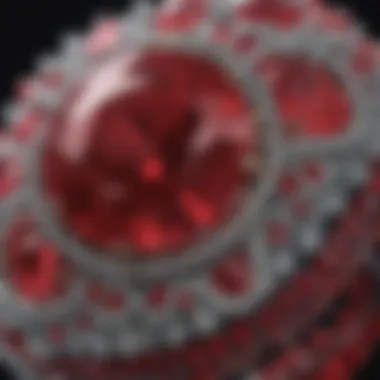
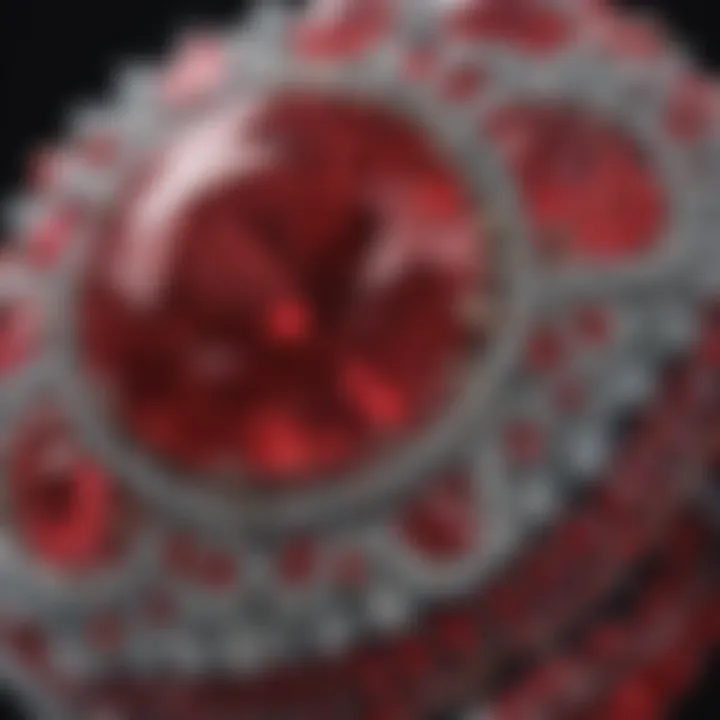
Professional grading tiers provide additional insight into the ruby's value assessed by experts in gemology. Various organizations offer certification that can greatly impact marketability and pricing. The most notable grading entities include the Gemological Institute of America (GIA), the American Gem Society (AGS), and the International Gemological Institute (IGI).
- GIA: The GIA is known for its comprehensive analysis of gemstones. Their grading reports are widely accepted as the standard in the industry. They emphasize precision by evaluating all Four Cs and providing a detailed report.
- AGS: The AGS also employs a detailed grading process similar to the GIA. They combine the Four Cs with additional attributes like light performance and optical symmetry.
- IGI: The IGI offers credibility for international buyers. Their reports ensure that the ruby's quality aligns with market expectations.
Grading tiers serve as a trust signal for buyers, offering assurance that they are purchasing a gemstone with undisputed value. Collectors and enthusiasts benefit immensely from these assessments as they navigate the intricate web of gemstone acquisition.
Market Trends for Carat Rubies
Understanding the market trends for 4 carat rubies is essential for collectors, jewelers, and enthusiasts aiming to navigate the complexities of gemstone acquisition. This section sheds light on the current demand, pricing behaviors, and prospective investment value inherent in these alluring gems. With these insights, stakeholders can make informed decisions based on substantial data rather than impulse or outdated information.
Current Demand Insights
The demand for 4 carat rubies has seen notable fluctuations in recent years. Several factors contribute to this demand, including cultural significance and changing consumer preferences. Rubies, often regarded as the "king of gems," carry a timeless charm that appeals to both traditional buyers and modern collectors.
A growing trend for ethically sourced gemstones has heightened interest in rubies that come with certification. Consumers are increasingly drawn toward brands that prioritize responsible mining practices. Understanding these trends helps stakeholders to adapt their offerings and discuss their gemstones with potential buyers effectively.
Additionally, the rise of online marketplaces has broadened access to rubies, making them easier to procure. This increased accessibility fuels demand since it allows individuals from varied backgrounds to enter the market.
Price Fluctuations
Prices of 4 carat rubies vary significantly based on various aspects such as origin, color, and quality. Over the past few years, reports illustrate a general upward trend in ruby prices. However, this rise can be unpredictable due to various market dynamics. Economic factors, including global economic conditions and luxury item demand, have implications on pricing.
Generally, premium rubies, especially those with deep color saturation and minimal clarity issues, often see higher appreciation in value. Yet, less-desirable variations can see stark reductions in market price, leading to an intricate pricing environment. Following market analyses will aid buyers in time their purchases more wisely.
Investment Potential
Investing in 4 carat rubies can be appealing, especially with rising prices and increasing demand. Rubies have historically demonstrated their value preservation over time, contrary to volatile investments. They offer a tangible asset that can potentially appreciate in value and become a legacy piece.
When considering investment opportunities, potential buyers should look for:
- Certification: Ensure the ruby comes with a recognized grading report.
- Quality Attributes: Prioritize color and clarity as essential factors in value.
- Market Trends: Keeping abreast of economic conditions and luxury market movements can influence investment timing.
Investing in gemstones like rubies is not just about aesthetics; it requires a thorough understanding of market trends to maximize returns.
Buying a Carat Ruby
When considering the purchase of a 4 carat ruby, it is important to grasp the significance of this choice. The decision extends beyond mere aesthetic appeal; it embodies a confluence of investment, emotional resonance, and personal style. A 4 carat ruby is not only a gemstone but a statement piece, often symbolizing passion, love, and luxury. Understanding what one must consider while buying is paramount to ensure a satisfying and wise investment.
What to Consider
Before making a purchase, several crucial factors should be evaluated.
- Budget: Determine a realistic financial plan. Prices for a 4 carat ruby can vary significantly based on quality and market demand. Generally, a higher quality ruby can command premium pricing.
- Quality Attributes: Pay attention to the color intensity, clarity, cut, and carat weight, often referred to as the Four Cs. Each attribute plays a vital role in the overall appeal and value of the ruby.
- Source and Origin: Researching the origin of the ruby can provide insights into its authenticity and ethical considerations. Rubies from distinguished sources like Burma, Thailand, or Madagascar carry different attributes and market values.
- Setting: Consider how the ruby will be set in jewelry. Some settings may enhance the ruby’s natural beauty while ensuring durability.
- Purpose: Establish the purpose behind the purchase. Is it a gift, personal indulgence, or an investment? This will guide the selection process significantly.
Identifying Authenticity
Ensuring that a 4 carat ruby is authentic is critical in making a sound investment. Here are some steps to help with identifying authenticity:
- Certificates: Always request a grading report from a reputable gemological laboratory, such as the Gemological Institute of America (GIA) or the American Gem Trade Association (AGTA). These certificates provide detailed evaluations of the gem’s properties.
- Visual Inspection: Look for natural inclusions known as "silk," which are characteristic of genuine rubies. Synthetic rubies often lack these unique features.
- Color Examination: Genuine rubies possess a deep, vibrant red hue. Consult a color chart to understand the gradations in ruby coloration.
- Price Point: Be cautious of deals that seem too good to be true. An incredibly low price can be an indicator of a synthetic or treated stone.
- Expert Consultation: If unsure, consult with a professional gemologist. Their expertise can provide a second opinion and peace of mind regarding authenticity.
The purchase of a 4 carat ruby is not merely a transaction; it is an investment in beauty and heritage, which remains significant through generations.
Caring for Your Ruby
Caring for a ruby is an essential aspect that often gets overlooked but is vital to maintaining its beauty and value. Rubies, like all gemstones, require specific care to ensure they remain in optimal condition over time. Neglecting proper care can lead to scratches, dullness, or even damage that could diminish their worth. Given the investment involved in purchasing a 4 carat ruby, understanding how to care for this gemstone is prudent for enthusiasts and collectors alike.
Cleaning Guidelines
Cleaning a ruby must be approached carefully to avoid harming the stone. Here are some effective cleaning procedures:
- Use Mild Soap: A mixture of warm water and a few drops of mild dish soap works well. Avoid harsh chemicals that can damage the stone or its setting.
- Soft Cloth: Employ a soft cloth or a very soft brush, like a baby toothbrush, to gently scrub the ruby. This helps remove dirt and oils without scratching the surface.
- Rinse Thoroughly: After cleaning, rinse the ruby under lukewarm water to wash away any soapy residue.
- Drying: Use another clean, dry soft cloth to pat the ruby dry. Avoid high heat and never use paper towels, which may cause scratches.
"Proper cleaning practices not only maintain beauty but also allow the wearer to appreciate the gem's unique characteristics."
Employing these techniques not only improves the gemstone's aesthetic but also enhances its longevity. Regular maintenance prevents buildup that can obscure the ruby's brilliance.
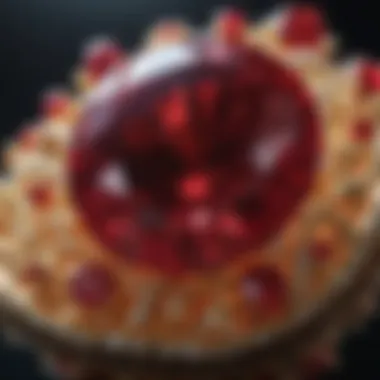
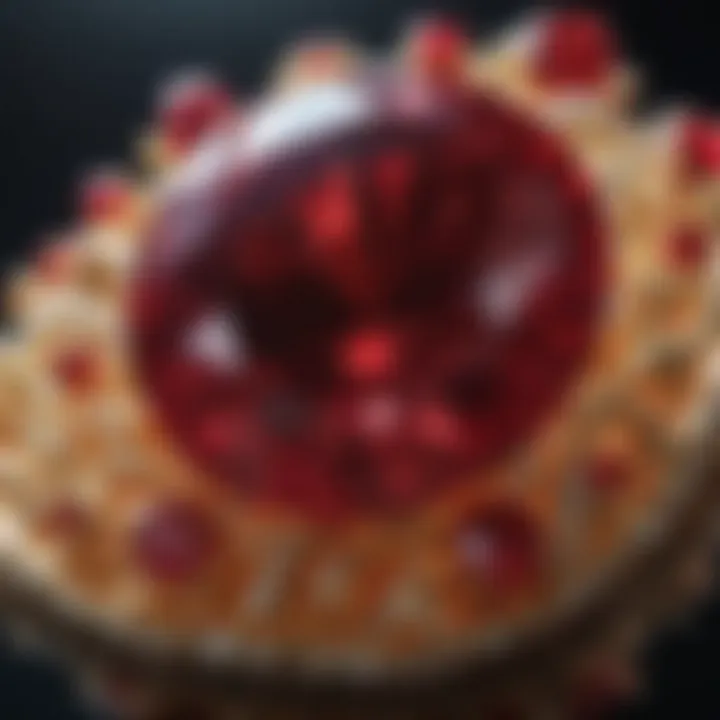
Storage Best Practices
Storing your ruby correctly is equally important as cleaning. Improper storage can lead to scratches or exposure to conditions that could adversely affect the gemstone.
- Separate Storage: Store your ruby separately from other jewelry. A soft pouch or a dedicated compartment in a jewelry box minimizes the chance of scratches.
- Avoid Direct Sunlight: Long exposure to sunlight can alter the color of some rubies. Keeping them away from direct light preserves their original hue.
- Cool, Dry Place: Store rubies in a cool and dry location. High humidity or heat can impact the clarity of rubies over time.
- Use a Jewelry Box: A lined jewelry box offers protection and organization. If possible, include silica gel packets to absorb excess moisture.
By adhering to these storage practices, users can avoid potential damage and ensure their rubies retain their allure for years to come. Regular care combined with mindful storage supports the ruby’s intrinsic value.
Myths about Rubies
Rubies have long been cherished for their beauty and rarity, but alongside their allure lie numerous myths that can cloud the understanding of these gemstones. Addressing the misconceptions surrounding rubies is crucial for enthusiasts, collectors, and jewelers as it cultivates a better appreciation for their true value. This section of the article seeks to clarify common and historical myths associated with rubies, helping readers grasp the realities of these remarkable stones.
Common Misconceptions
Many common misconceptions exist about rubies. One prevalent myth is that all rubies are red. While red is indeed the defining color for rubies, they can sometimes feature hues of purple or pink. The quality of the color can also vary widely. A deep pigeon blood red is often considered ideal, but other shades have their own appeal.
Another misunderstanding relates to treating rubies. Some believe that all rubies are untreated and naturally mined. In fact, many rubies undergo treatments to improve their color and clarity. Treatments can include heat treatment, which enhances their color, and glass filling to reduce visible inclusions. Knowing the treatment status is essential when evaluating their value and authenticity.
Additionally, there is a notion that rubies are more durable than other gemstones. While rubies are indeed hard, scoring 9 on the Mohs scale, they are not invincible. Everyday wear can still cause chips or scratches. Thus, it is essential to care for them properly, as explained in previous sections on caring for rubies.
"Understanding the reality of rubies enhances appreciation and promotes informed buying decisions."
Historical Myths
Historically, rubies have been surrounded by various myths that originated in different cultures. In ancient times, they were often associated with blood and were believed to hold magical powers. For example, in some traditions, carrying a ruby was thought to guarantee safety in battle and to bring victory. Such stories elevated rubies to the status of talismans or protective stones.
Another historical myth pertains to the origin of rubies. Many people associate rubies primarily with Myanmar, formerly called Burma, as this location produced some of the most prized stones. However, significant deposits can also be found in Sri Lanka, Thailand, and Africa. This geographical misconception can lead buyers to overlook quality stones sourced from other regions.
Lastly, a myth persists that rubies are exclusively for the wealthy. While high-quality rubies can indeed command high prices, there are also more affordable options available in the market, especially for those willing to consider treated stones or those of lesser quality. This accessibility opens up the world of rubies to a broader audience.
In summary, debunking myths about rubies not only increases knowledge but also serves as a guide for better choices in the selection and care of these gemstones. Understanding both common and historical misconceptions allows enthusiasts to appreciate rubies in their rightful context.
Ethical Sourcing of Rubies
Ethical sourcing of rubies plays a critical role in today’s jewelry market. As consumers become more aware of the origins of their gemstones, issues like human rights abuses, environmental sustainability, and community impacts are gaining more attention. The demand for ethically sourced stones is not just a trend but an essential consideration in purchasing decisions. This section examines the significance of ethical sourcing in the ruby industry and highlights the broader implications for both buyers and suppliers.
Understanding Ethical Practices
Ethical practices in sourcing rubies encompass a variety of standards and considerations. This includes ensuring that the rubies are mined under fair labor conditions and that the communities involved receive fair compensation. Many ruby mines are located in developing countries, where labor laws may not be strictly enforced. Therefore, buyers need to ensure that their sources adhere to ethical treatment of workers.
Some of the ethical practices to look out for when sourcing rubies include:
- Certification: Look for certifications from organizations like the Responsible Jewelry Council, which ensures that mines operate with ethical practices.
- Transparency: Sellers who provide clear information about the supply chain show their commitment to ethical sourcing.
- Fair Trade agreements: These agreements ensure that producers get a fair price for their rubies, promoting sustainable development in mining areas.
- Environmental Standards: Ethical mines should also maintain practices that protect local ecosystems and minimize damage during extraction.
By following such ethical practices, buyers can contribute to a responsible industry while also ensuring the quality and value of their gemstones.
Impact on Market Demand
The increasing emphasis on ethical sourcing significantly impacts market demand for rubies. Consumers, particularly younger generations, are showing a preference for ethically sourced products. This shift is challenging traditional models of gemstone trading and pushing industry players to adapt accordingly.
Key impacts on market demand include:
- Increased Consumer Awareness: As educational resources become readily available, buyers are more informed about the implications of their purchases.
- Growth of Ethical Brands: Brands that market their rubies as ethically sourced tend to resonate more with consumers, resulting in higher sales and brand loyalty.
- Price Premiums for Ethical Stones: Ethically sourced rubies often command higher prices due to their limited and responsible sourcing. Buyers see the value in ensuring they are contributing to sustainable practices.
- Shift Towards Online Retail: Many consumers are turning to online platforms to find ethically sourced rubies, enabling greater access and transparency compared to traditional retail.
"Ethical sourcing is no longer just an option in the gemstone market; it's becoming a necessity that is reshaping the entire industry."
The importance of ethical sourcing goes beyond mere consumer choice. Its impact is now felt across all levels of the market, driving better practices and improving the conditions within the ruby mining industry. To make informed buying decisions, it is crucial for consumers to remain engaged and knowledgeable about the ethical implications of their purchases.
Closure
Summary of Key Points
- Carat Weight Significance: The carat weight of a ruby directly influences its value, and the distinction between a 4 carat ruby and smaller sizes is crucial for collectors and investors.
- Grading Criteria: The Four Cs—color, clarity, cut, and carat—serve as a framework for assessing rubies’ overall quality, impacting their marketability.
- Market Trends: Awareness of current demand and price fluctuations is vital for potential buyers and sellers to make strategic investment decisions.
- Ethical Sourcing: Understanding the importance of ethical practices in sourcing rubies is paramount for fostering sustainability in the gemstone industry.
- Care and Maintenance: Proper care, including cleaning and storage, prolongs the life and brilliance of 4 carat rubies, securing their value over time.
Future Outlook for Carat Rubies
The future of 4 carat rubies appears promising, influenced by several evolving factors. Increasing demand for ethically sourced gemstones is expected to drive market prices higher, encouraging both collectors and investors to prioritize responsible purchasing practices. Furthermore, with more interest in unique designs and custom pieces in jewelry, the versatility of 4 carat rubies makes them an attractive option.
Market researchers predict that appreciation for colored gemstones will continue to rise as consumers seek individuality in jewelry. As awareness of the intricate properties of rubies grows, so too does the potential for increased investment and interest in the segment. Overall, the future of the 4 carat ruby market looks bright, holding exciting prospects for enthusiasts and collectors alike.
"The allure of rubies transcends beyond aesthetics; it embodies history, culture, and ethical responsibility. Understanding these facets is essential for any serious collector or enthusiast."
As the market evolves, staying informed about trends and practices will be integral for success in acquiring and maintaining the value of 4 carat rubies.







